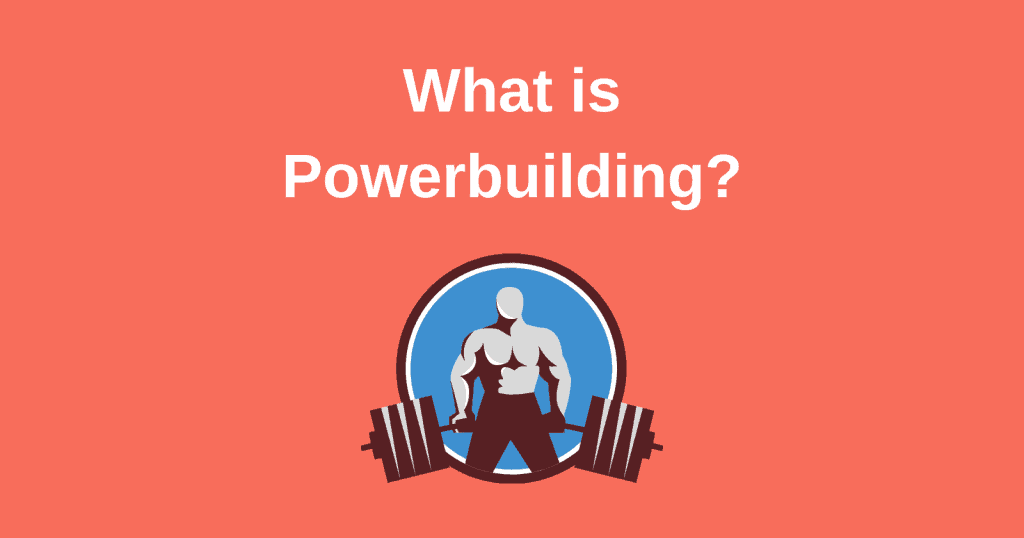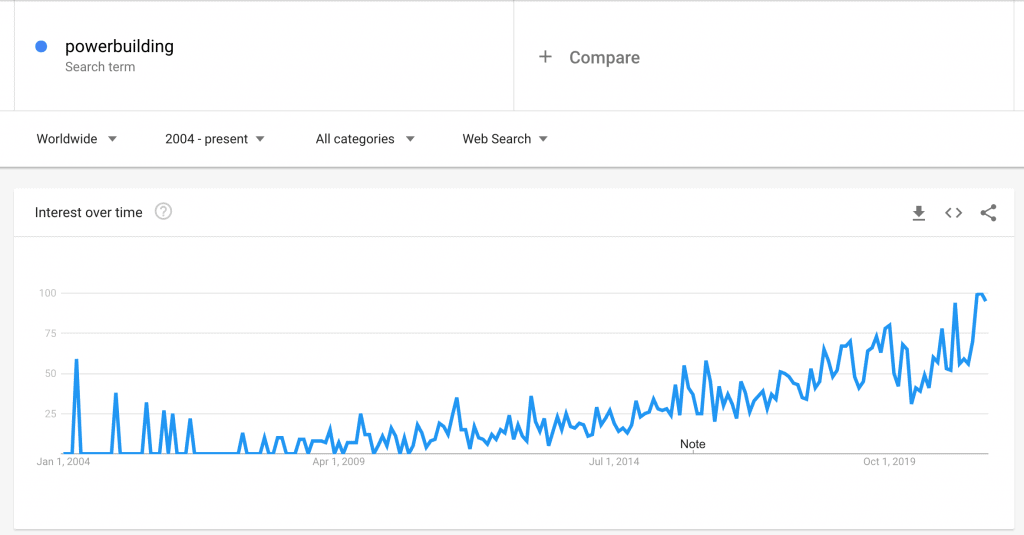For the last several decades, a civil war has been raging within the strength training community.
On one side stands an army of thick-necked powerlifters uniformed in sweat-stained Westside Barbell t-shirts. On the other looms a legion of bodybuilders, jacked, tan, and displaying perfect symmetry as they pose threateningly with shakers full of creatine monohydrate and protein powder.
Those in the former camp argue that the pursuit of strength trumps all. Those in the latter cite the philosophy of aesthetics as their primary motivation for performing rep after punishing rep.
All the while, another, more rational subset of strength athletes has sat quietly on the sidelines pondering the obvious question: why can’t you have both?

Thus, powerbuilding was born.
So what is powerbuilding, otherwise unceremoniously known as the bastard child of two ideologically opposed yet inextricably linked approaches to pumping iron?
Table of Contents
What Is Powerbuilding?
Powerbuilding is a combination of two training methods: powerlifting and bodybuilding. It blends the raw strength-building potential of powerlifting with the quest for visual enhancement that characterizes bodybuilding.
Athletes who utilize a powerbuilding framework for their training don’t stubbornly limit themselves to one set of goals or another—they want to increase their overall strength while also becoming bigger, leaner, and more anatomically impressive.
As such, powerbuilding tends to be highly structured and numbers-driven, like powerlifting, but leaves room for a wide variety of hypertrophy-focused exercises and auxiliary training methods, like bodybuilding.
Diehard devotees of either discipline often claim that you can’t have “show” and “go.” While there may be some truth to this at elite levels of competition, a growing body of scientific research, as well as many athletes’ personal experience, clearly demonstrates that strength and aesthetics are not mutually exclusive.
The Rise of Powerbuilding
Powerbuilding began growing in popularity around 2014 according to Google Trends data.
Despite this, powerbuilding remains significantly less popular than powerlifting and bodybuilding.

Powerbuilding Goals
Most people who make a habit out of picking up and putting down heavy objects do so for one of two reasons: to get stronger or to look better. Strength athletes who have adopted the tenets of powerbuilding assign themselves the formidable task of doing both these things at the same time.
As counterintuitive as these goals may seem on the surface, they’re more closely related than many athletes believe.
Think back to your first couple years of training.
If you were like most beginners, you were hitting PRs practically every week. At the same time, your body was undergoing a radical transformation—your shoulders and thighs were broadening, your body fat was melting away, and sleek, contoured masses of muscle were starting to form where previously there were only smooth, straight lines.
In other words, both your strength quotient and your body composition were improving simultaneously. Every new trainee, without exception, experiences this phenomenon. It’s the rule, not the exception.
But those thrilling early gains only last so long. As you move further down the path of progress, you reach an apparent fork in the road, with strength lying in one direction and an awe-inspiring physique lying in the other.
Too many lifters succumb to the pressure to specialize in order to excel rather than attempting to find the kind of middle ground that the forebears of modern strength training used to strive for.
If you need further convincing that strength and aesthetics are compatible, just take a look at athletes like Eugen Sandow, George Hackenschmidt, and John Grimek, all of whom were dominant in both domains during their days.
More recently, bodybuilders like Chris Cormier, Johnnie Jackson, Stan Efferding, and living legend Ronnie Coleman have been blurring the lines between visual appeal and freakish strength.
Powerbuilding Exercises
Powerbuilding is centered around the “big three” lifts that define the modern sport of powerlifting: the squat, bench press, and deadlift. Some lifters also consider the overhead press a kind of unofficial fourth lift, despite the fact that it’s not technically a powerlifting event.
What do these lifts have in common? They all demand high levels of coordination, stability, and force generation throughout a complex of joint and muscle groups.
Prioritizing compound lifts is arguably the most effective means of gaining strength. But as it turns out, it’s also a great way to build muscle.
After all, the basic formula for hypertrophy is time plus tension. Compound lifts serve to distribute that tension throughout the entire body rather than restricting it to a single muscle or group of muscles the way isolation exercises do.
A typical powerbuilding workout therefore begins with one of the three main lifts listed above. Only after the lifter has completed a few high-intensity sets of their scheduled compound lift do they shift their focus to stimulating new muscle growth. At this point, the range of accessory exercises available to them expands dramatically.
On a lower body day, for example, an athlete might start their workout routine with heavy back squats in the 3-5 rep range, then perhaps do 2-3 additional sets of a squat variation with a smaller load to drill technique and accumulate fatigue.
From there, the intensity goes down and the volume goes up. The second half of the workout might consist solely of movements that have historically been used to increase size, such as leg presses, hack squats, lunges, stiff-legged deadlifts, leg extensions, and calf raises.
Similarly, a powerbuilder might kick off an upper body day with a few brutal doubles or triples on the bench press, then be repping out dumbbell flyes or skull-crushers ten minutes later.
Other mass-manufacturing favorites—lat pull-downs, military presses, dips, preacher curls, delt raises, etc.—are not off-limits to powerbuilders the way they are to powerlifters, who have to worry about how extraneous output might affect their performance leading up to and during competition.
By making use of powerbuilding-style, you have the potential to take your lift total and your physique to previously unseen heights.
Powerbuilding Programs
Popular picks: PHAT, PHUL, Brogains
Though getting strong and looking good doesn’t have to be a binary choice, formulating programs that successfully further both of these ends can be tricky.
Broadly speaking, powerbuilding programs incorporate low-volume, high-intensity and high-volume, low-to-moderate intensity protocols together. In some cases, these protocols may be prescribed separately in phases, similar to the alternating bulk and cut cycles well-known to bodybuilders. More often, they’re integrated into the same week or workout.
This is the sort of best-of-both-worlds strategizing that gives the training style its name.
The majority of powerbuilding programs call for around 3-5 training sessions per week, which is consistent with both traditional powerlifting and bodybuilding regimens.
However, the programming parameters of powerbuilding frequently create opportunities for athletes to add in extra workouts as they see fit, as it’s possible to prioritize certain accessories and splits without impacting performance in the three primary lifts.
The ultimate aim of merging these two modes of training is to pack on as much functional muscle mass as possible while ensuring that that muscle isn’t covered up with unnecessary fat and water weight.
For more info on the finer points of powerbuilding programming, be sure to check out our page detailing the 10 best powerbuilding programs you can begin running today.
Powerbuilding vs. Powerlifting
Just how much overlap is there between powerbuilding and powerlifting? And where are the two disciplines at odds?
Hint: it’s right there in the name.
Similarities
As mentioned, powerbuilding exalts the same core trio of compound lifts as powerlifting, namely the squat, bench press, and deadlift. Powerbuilders dedicate a significant portion of their workouts to getting better at each of these lifts, often implementing the same sorts of programs, rep ranges, and technical cues as powerlifters.
In powerbuilding, just like in powerlifting, PRs matter. The time you spend in the gym isn’t just about chasing a pump or bringing up visual weak points. It’s about working with increasingly heavy loads, refining your technique, and generally becoming more efficient.
Powerbuilders are adamant about tracking their performative progress. Like their powerlifter brethren, they document everything and put a lot of brainpower towards troubleshooting issues that are holding back their main lifts.
Differences
The biggest difference between powerbuilding and powerlifting is that while the average powerlifter is only concerned with getting strong, powerbuilders also care about maintaining an impressive physique.
To this end, their workouts draw on a wealth of accessory exercises that are commonly associated with bodybuilding. Movements that powerlifters might deem counterproductive, like rows, curls, tricep extensions, and shrugs, are indispensable for powerbuilders. The same is true of cardio, which many powerlifters avoid like the plague for fear that it will degrade the fast-twitch muscle they need to explode through their lifts.
Outside of the gym, powerbuilders may also follow slightly different dietary guidelines than powerlifters.
Powerlifters eat to maximize their available energy. Powerbuilders, on the other hand, often consume copious amounts of protein but restrict fat and carbs to keep their net calories down and prevent undesirable weight gain.
Powerbuilding vs. Bodybuilding
Powerbuilding shares bodybuilding’s vision of the fully-realized human form as a work of art. What it doesn’t share is the latter’s somewhat one-dimensional standards of success.
Similarities
Both powerbuilders and bodybuilders have an abiding appreciation for well-sculpted muscle. To a powerbuilder, having a big chest is every bit as important as having a big bench press. (And not just because it translates to more leverage and less range of motion.)
Powerbuilding places a good deal of emphasis on things like proportion, symmetry, and body fat percentage. According to the doctrine of powerbuilding, there’s no point in going to all the trouble of building a bunch of muscle if no one can see it.
Powerbuilders aren’t too proud to have a session devoted entirely to abs, nor do they have any qualms about curling in the squat rack—so long as no one is waiting to use it.
Differences
It’s not enough for a powerbuilder to have the body of a demigod. They also crave the power that comes with it.
Far more of a powerbuilder’s time is therefore spent analyzing motor patterns and skimming strength studies than sitting in the sauna or comparing vascularity supplements. Since the ability to move massive loads is (more or less) half of the powerbuilder’s purpose, they aren’t satisfied with simply being admired for their outward appearance.
Simply put, powerbuilders train to develop muscle that talks the talk and walks the walk.
Conclusion
Powerbuilding is more than just a mash-up of the names of its two progenitive disciplines. With all of this information, you are now prepared to answer the question: what is powerbuilding?
It’s a profound, comprehensive methodology that seeks to restore harmony to the chaotic strength training cosmos by uniting two seemingly disparate but ultimately complementary goals: get insanely strong and look great while doing it.
It’s time for lifters to evolve beyond the tired strength-size dichotomy and awaken to what both styles of training have to offer. With powerbuilding, you don’t have to settle for simply getting bigger or stronger. Achieving both goals is not only possible but arguably the highest expression of what strength athletes do.